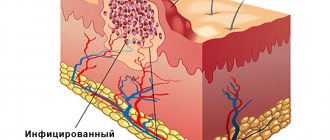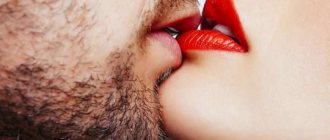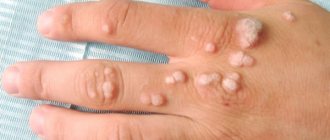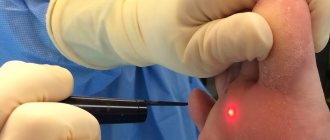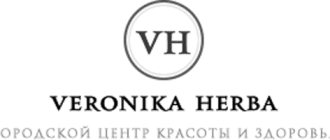Warts do not cause painful or itchy sensations, but observing them on any part of the body certainly does not give a person pleasure. In addition, over time they can grow and spread to other areas, and if accidentally damaged they have a risk of malignant degeneration. Therefore, it is better to remove such tumors in a timely manner.
Clinic "PsorMak" removes plantar and other warts in the safest and most painless way today - using the Surgitron device. It has several advantages over other techniques, including the ability to remove different types of warts.
Preparing to remove a wart
At the initial appointment, the doctor examines the patient and assesses the condition of his skin: the size and number of warts, skin type, thickness. At the same time, a survey is conducted to determine how long ago the wart was formed and the rate of its development.
If wart cell degeneration and other pathologies are suspected, the dermatologist will refer the patient for tests to determine the type of virus that provoked the formation of the growth.
Immediately before removing the wart, the patient should donate blood for the presence of HIV, syphilis, hepatitis B and C. There is no need for preoperative observation of the patient in the ward.
Is it possible to remove warts once and for all?
In most cases, skin tumors are removed permanently. Especially if the procedure is performed professionally. However, we must not forget that this is a viral disease, and therefore without immune support you risk encountering it again.
Therefore, the question of whether warts need to be removed is far from the main one in this case. First, figure out the reason for their appearance. High-quality vitamin support will help strengthen the body's defense systems. And first of all, in the form of vitamin D3. Is there not enough sun for it to be produced in abundance? It doesn’t matter - there are special preparations that contain it in the required volume. For example, Osteo-Vit D 3 .
Herbal remedies based on the herb Echinacea purpurea and Eleutherococcus senticosus root have also proven themselves to be effective in strengthening the immune system.
How is wart removal performed surgically?
On the day appointed for the operation, the patient arrives at the clinic. Having received special sterile clothing, he changes clothes and goes to the operating room prepared for him. Excision of warts with a scalpel is a simple surgical operation. To carry it out, it is sufficient to use local anesthesia, which most often takes the form of an injection of lidocaine or drugs similar in action to it.
At the first stage, the surgical field is treated with a disinfectant. Then the surgical area is injected with lidocaine in several places in the immediate vicinity of the future incision site. 5-10 minutes after the injection, the operation to remove warts can begin.
With a precise movement of the scalpel, the surgeon makes an incision in the area of the wart and exposes its subcutaneous part. After this, holding the tumor with tweezers, pathological tissues are removed from the surrounding healthy skin. At this point, some of the surrounding tissue is also removed in order to ensure that all of the warts are removed and to prevent re-infection with the papilloma virus remaining in the skin.
After this, the resulting surgical wound is sutured using catgut. Removal of this suture material is not required, as it dissolves in the skin tissue approximately a week after application. The suture is located inside the skin, so the scars from the intervention are not noticeable. This makes this wart removal method applicable even on exposed parts of the body, including the face.
Features of the procedure
Laser removal of warts occurs under local anesthesia. Lidocaine or another local anesthetic is injected under the wart or into the area of nerves near it. Usually, one session is required. However, when there are a lot of warts, it is necessary to limit the dose of painkillers administered to avoid side effects. The healing time depends on the size and location of the wart. The smallest ones on the fingers heal in 1 week. Plantar warts take much longer to heal, like any wound on the foot. You must pre-register.
Disadvantages of the surgical method
If there are many warts on the patient’s body and they are all located in different areas, it is advisable to schedule their removal in several stages.
The downside is the fact that with large-scale interventions, scars on the body may still remain. This happens if for some reason a decision is made to apply not a cosmetic, but an ordinary silk suture to the wound. However, this only applies to operations not performed on the patient’s face.
After removing warts with a scalpel, there is a high probability of tissue re-infection with the human papillomavirus. For this reason, the patient should definitely undergo antiviral treatment prescribed by the doctor. After completing the course, it is necessary to follow the recommendations for the prevention of this disease and carefully maintain the functioning of the immune system.
Varieties
- Vulgar warts - or ordinary, round, rough, wide growths on the skin of mainly the fingers, often appear in young people, which is why they are also called juvenile warts. Always caused by HPV viruses. If left untreated, warts can spread to other people and spread to other areas.
- Plantar warts (plantar warts) are warts on the feet, mainly on the soles of the feet, but not necessarily on the toes. Very wide, they may or may not have dark dots in the center from clogged vessels. In the latter case, people consider them corns, grow them for years, and infect family members and other people with HPV. It is really difficult to distinguish them, the corns are located in places of friction and are symmetrical (in the absence of flat feet on one side).
- Flat warts are a rare type of wide, reddish, round plaques on the skin in a variety of places: on the face, arms, legs. Flat warts are also viral in nature (HPV). However, they more often appear in people with very weak immune systems and affect large areas at once.
- Genital warts are warts in the groin and anus. The reasons for the appearance are the same - HPV viruses. However, in such areas there is a risk that viruses will contribute to the development of vulvar cancer or anal cancer. For genital warts they came up with a special name - condylomas.
Contraindications for surgical excision of warts
Removing warts using the classical method has a minimal number of contraindications compared to other, more gentle options. However, the intervention in this case, although small, is still important, so the operation is not performed in the following cases:
- Pregnancy and breastfeeding;
- Exacerbation of herpes;
- Infectious diseases;
- Inflammatory processes in the body.
All of the above contraindications relate to temporary factors. As soon as the patient’s body returns to normal, the wart can be removed.
Why is it better to remove warts using the Surgitron device?
The low price for removing warts with the Surgitron device is not the only advantage. The main advantage of the procedure is safety, since it allows you to take tumor tissue for a biopsy. It is necessary to determine the nature of the formation - benign or malignant.
The PsorMak clinic offers the removal of warts in a clinic in Moscow using the Surgitron device. It belongs to the field of radiosurgery, and is based on the effect of radio wave radiation on tissue. Removal of warts with the Surgitron apparatus is also possible in children. The reason for this is the advantages of this technique:
- painlessness;
- fast healing;
- absence of scars and cicatrices;
- speed of the procedure itself;
- minimal risk of bacteria entering the wound;
- absence of inflammatory processes after the procedure.
If you would like to quickly and painlessly get rid of a wart forever, contact the PsorMak clinic. To make an appointment, use the contact number or feedback form.
Recovery after wart removal
Any operation, including the removal of wart tissue, requires some time for the body to fully recover. This process can take several days or several weeks, depending on the individual characteristics of the patient. The size of the removed tumors, their number, depth and other parameters are of considerable importance - the more there are and the wider the affected area, the larger and more difficult it will be to restore the skin. During this period, you should follow your doctor’s instructions and carefully monitor your condition.
Among the universal recommendations during the recovery period after surgical removal of warts are:
- Refusal to visit the solarium, beach and other places where people are in the open sun without an umbrella or clothing;
- Keeping the wound clean and dry, minimal contact with water;
- Strict hygiene;
- Systematic treatment of the suture area with an antiseptic.
The instructions also include refraining from opening a postoperative wound and prematurely removing the crust formed on the sutures. This can lead to infection of the wound, suppuration, infection of healthy tissue and other, more serious consequences.
If surgery was performed to remove a wart on the sole, you should minimize the stress on your feet. Constantly standing on your feet can cause bleeding, wound opening, infection and prolongation of the rehabilitation period several times.
Types of warts
Warts are tumor-like pathological elements on the surface of the skin or (less commonly) mucous membranes.
There are several types of warts, which differ in appearance and location. Common warts are most often located on open, easily injured areas (knees, fingers, hands) and are dense, painless nodules covered with intact skin. Over time, cracks and growths appear on the surface of ordinary warts.
Plantar warts are localized on the soles of the feet in areas of increased pressure or friction from shoes. In its development, this type of wart goes through an evolution from a small shiny nodule to a rough plaque covered with keratinized scales. Plantar warts, as a rule, are not numerous (up to 3-5 elements), but they cause a lot of trouble for their owner due to severe pain.
Surgical removal of warts in children
Warts in children are common. Doctors do not always prefer to resort to surgical removal of warts in young patients. Initially, they choose treatment with pharmaceuticals such as patches, topical ointments and gels. However, antiviral treatment is necessary. If these measures do not give the desired effect and the warts continue to grow, a decision is made to perform surgery.
Removing warts using a scalpel in children is advisable only if it is not possible to do it in a more gentle way. If the warts do not cause discomfort to the child, there is a possibility that the doctor will prefer to delay removal until the child is 10-12 years old, since adolescence is the optimal age for this operation in children.
Attention!
This article is posted for informational purposes only and under no circumstances constitutes scientific material or medical advice and should not serve as a substitute for an in-person consultation with a professional physician.
For diagnostics, diagnosis and treatment, contact qualified doctors! Number of reads: 4229 Date of publication: 08/09/2018
Dermatologists - search service and appointment with dermatologists in Moscow
Removal/treatment methods
Laser removal of warts - removal with high-energy light beams. Under the influence of the laser, the wart tissue evaporates down to the growth zone. Thanks to the narrowness of the laser beams and gradual evaporation, the removal is quite precise, which contributes to faster healing and good cosmetic results.
Radio wave removal of warts (surgitron) - removal with very high frequency electrical impulses, many times higher than removal with an electrocoagulator. Some people confuse radiowave ablation and radiotherapy (radiation therapy for cancer). Apart from the similarity in name, they have nothing in common. The high frequency of the pulses allows you to act only on the tissue of the wart, without causing a burn to surrounding healthy tissue. This also reduces the likelihood of unsightly scars and speeds up healing.
Removing warts with nitrogen - liquid nitrogen or other low-temperature substances are used. First, the wart cools, then thaws and begins to swell, blister and hurt. When using a cotton swab, it is difficult to remove exactly the area where the wart is located. Hence the high relapse rate. Products from the pharmacy do not have such a low temperature as nitrogen, and therefore are even less effective.
In what cases should you consult a doctor?
In fact, the question of whether a wart can be removed in a clinic or medical center should not arise in principle. To ensure that you get rid of the annoying formation and avoid complications, it is better to immediately trust the professionals.
You should not delay going to the doctor if:
- the wart is very large and causes serious moral or physical discomfort;
- there are many warts, and their number is only growing;
- Suspicious changes occur with the growth: frequent bleeding, abscesses, inflammation, etc.;
- home treatment did not bring a positive result;
- warts appeared on the face (remember the danger of condylomas);
- the neoplasm looks strange and looks more like a tumor.
Is it possible to remove warts during pregnancy and breastfeeding?
For expectant mothers, it is better to postpone the decision on whether warts need to be removed until the postpartum period, because any anesthesia or taking medications (even on a natural basis) during pregnancy is contraindicated. An exception can be made only in cases where the neoplasms are localized in the vagina or cervix, since there is a risk of infection of the baby during pregnancy and childbirth. All necessary recommendations in this regard can be obtained from your attending physician.
With the question of whether it is possible to remove warts during breastfeeding (breastfeeding), the situation is similar. However, the same electrocoagulation (at the patient’s request) can be carried out without anesthesia, since it does not cause serious discomfort. Consequently, the baby’s health is not in danger.
